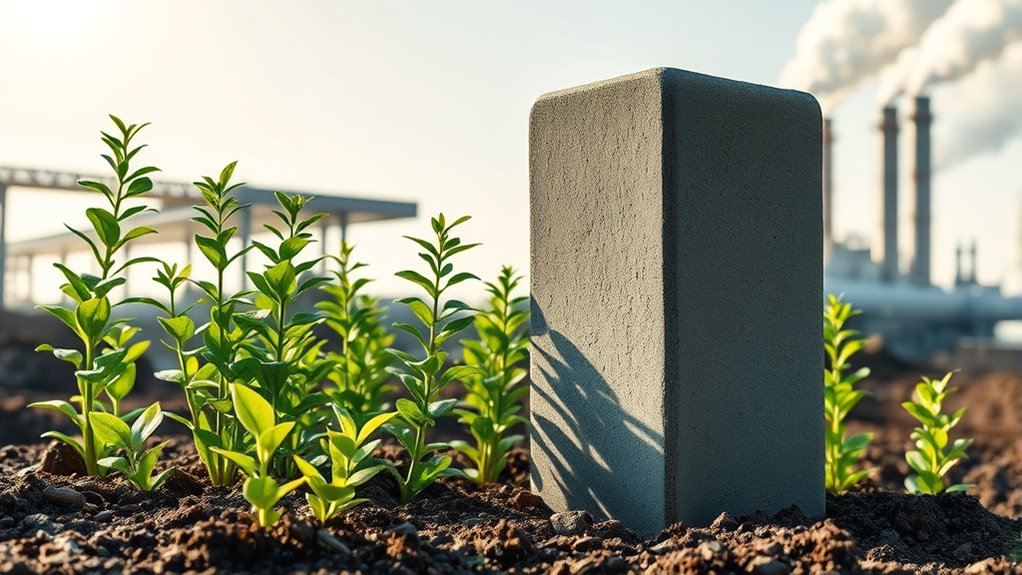A groundbreaking carbon-negative cement has hit the market, actively pulling more CO₂ from the atmosphere than it emits during production. Unlike traditional options, it uses innovative materials and incorporates carbon capture tech, helping reduce greenhouse gases and combat climate change. Its durable and sustainable design can transform infrastructure worldwide. If you want to understand how this new cement works and its potential impact, there’s much more to uncover below.
Key Takeaways
- A pioneering carbon-negative cement product has recently been introduced to the market, actively sequestering more CO₂ than it emits.
- The cement incorporates waste materials and utilizes innovative material science to enhance environmental sustainability.
- It relies on advanced carbon capture technology during production, making it a significant breakthrough in eco-friendly construction materials.
- The launch marks a major step toward reducing the construction industry’s carbon footprint and promoting climate mitigation efforts.
- Widespread adoption depends on performance, durability, regulatory approval, and market acceptance of this sustainable alternative.
The Innovation Behind Carbon‑Negative Cement
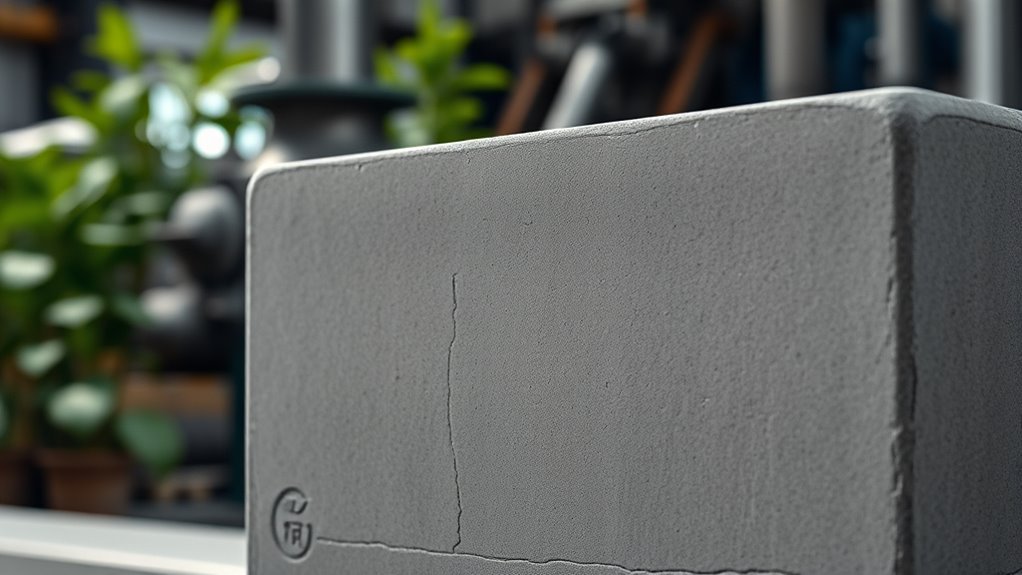
What makes carbon-negative cement truly innovative is its ability to absorb more CO₂ than it emits during production. This breakthrough stems from advanced recycling innovations that incorporate waste materials into the cement mixture, reducing reliance on traditional raw resources. Material science plays a pivotal role here, enabling engineers to develop new formulations that enhance CO₂ absorption during curing. By rethinking cement’s core components, scientists create a product that acts as a carbon sink, actively pulling in atmospheric CO₂. These innovations not only cut emissions but also promote sustainable practices by recycling industrial byproducts. Additionally, continuous learning and experimentation are vital for advancing Material science and further improving the environmental impact of construction materials. As a result, this cement pushes the boundaries of eco-friendly construction, demonstrating how cutting-edge science can transform an age-old material into a tool for climate change mitigation.
How This Cement Differs From Traditional Variants

Unlike traditional cement, carbon-negative cement actively absorbs more CO₂ than it releases during production, making it a revolutionary alternative. This material innovation relies on enhanced carbon sequestration techniques, capturing and storing CO₂ within the cement itself. Traditional cement emits significant greenhouse gases due to calcination and energy-intensive processes, whereas this new variant not only reduces emissions but also pulls in atmospheric CO₂. Its unique composition involves innovative binders and additives that promote carbon absorption, setting it apart from standard formulations. Additionally, high contrast ratios in the cement’s properties enhance its visual and structural quality. The result is a sustainable building material that minimizes environmental impact while maintaining strength and durability. By rethinking cement’s chemistry, this technology offers a tangible way to combat climate change through smarter, eco-friendly construction practices, and it exemplifies the benefits of sustainable material development. Incorporating advanced manufacturing techniques further improves its efficiency and scalability, and ongoing research aims to optimize its cost-effectiveness.
Environmental Benefits and Impact on Climate Change
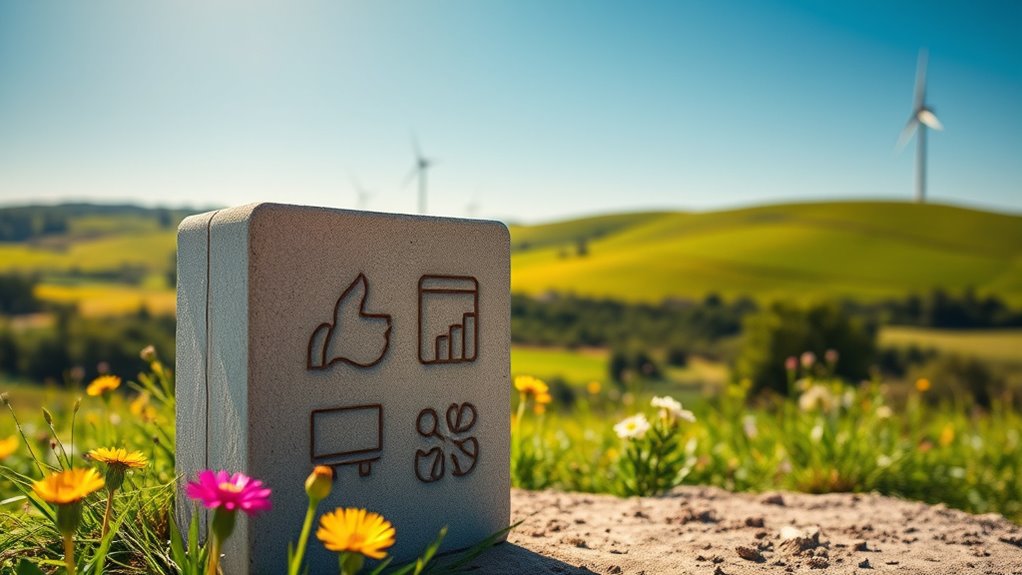
By choosing carbon-negative cement, you can substantially cut down on harmful emissions that contribute to climate change. This innovative material actively removes more CO₂ from the atmosphere than it produces. As a result, it offers a powerful way to help mitigate the environmental impact of construction projects. Incorporating organic and natural materials in manufacturing processes further enhances sustainability efforts and reduces reliance on synthetic components. Using carbon capture technology during production can significantly improve the cement’s environmental footprint. Implementing sustainable building practices can further maximize the positive environmental effects of this groundbreaking cement. Embracing environmentally friendly materials also supports broader ecological conservation initiatives.
Reduced Carbon Emissions
Reduced carbon emissions from carbon-negative cement considerably benefit the environment by lowering greenhouse gas levels in the atmosphere. This innovation relies on advanced carbon capture techniques embedded within the material itself, actively pulling CO₂ out of the air during production and curing. By integrating cutting-edge material innovation, manufacturers can markedly cut emissions compared to traditional cement. This process not only minimizes the carbon footprint but also helps offset emissions from other industries. As a result, you’re contributing to a cleaner environment and helping combat climate change. The ability to produce cement that absorbs more CO₂ than it emits marks a major shift toward sustainable construction. It’s a tangible step toward reducing overall greenhouse gases and fostering a healthier planet for future generations. Incorporating mindfulness practices into the development process can also enhance environmental awareness among stakeholders. Additionally, the development of carbon-negative materials demonstrates a promising approach to achieving truly sustainable infrastructure. Recognizing the importance of environmental impact assessments, manufacturers can optimize processes that maximize carbon sequestration, leveraging innovative technologies to further improve efficiency.
Climate Change Mitigation
As the world faces escalating climate challenges, adopting carbon-negative cement emerges as a crucial strategy for mitigating climate change. This material innovation not only reduces emissions but actively sequesters carbon, helping to lower atmospheric CO₂ levels. By capturing more carbon than it emits, this cement can slow global warming and support sustainable development. Its environmental benefits include enhanced carbon sequestration, reduced reliance on fossil fuels, and a smaller overall carbon footprint. Implementing this innovative cement can considerably impact climate change mitigation efforts. You can contribute to this positive change by supporting projects that prioritize low-carbon materials. Encryption solutions and secure communication technologies play a vital role in protecting the data related to these environmental initiatives. Additionally, the development of low-carbon construction materials is essential for scaling these environmentally friendly solutions. Recognizing the importance of state-specific tax laws can help in funding and promoting sustainable building practices. Incorporating advanced trailer music composition techniques can also help raise awareness and mobilize support for such environmental innovations. Together, these efforts help create a resilient, sustainable future for our planet.
The Production Process and Sustainable Materials
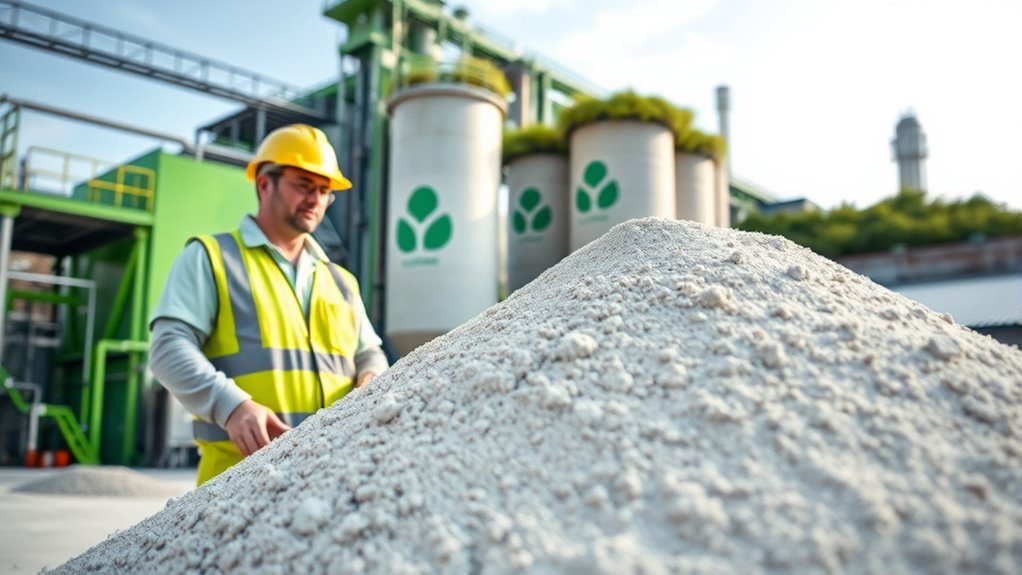
You can reduce cement’s environmental impact by adopting innovative manufacturing techniques that lower emissions. Choosing eco-friendly materials for production also helps create a more sustainable process. Together, these approaches make it possible to produce cement that’s truly carbon-negative. Additionally, integrating sustainable supply chains in the development process can further enhance the environmental benefits of eco-friendly cement production. Implementing exfoliation techniques such as glycolic acid can improve surface quality and durability in related construction materials. Utilizing renewable energy sources during manufacturing can significantly decrease carbon footprints associated with cement production.
Innovative Manufacturing Techniques
Innovative manufacturing techniques for carbon-negative cement focus on reimagining the production process to minimize environmental impact. These methods use alternative raw materials, energy-efficient processes, and carbon capture technology to reduce emissions. To boost market adoption, manufacturers are streamlining operations, lowering costs, and demonstrating the material’s durability. However, regulatory challenges remain, as authorities work to update standards for new cement types. Cutting-edge techniques include:
- Utilizing waste byproducts as raw materials
- Implementing renewable energy sources during production
- Integrating carbon capture and storage (CCS) technologies
- Developing modular, scalable manufacturing systems
Eco-Friendly Material Selection
Building on advancements in manufacturing techniques, selecting eco-friendly materials plays a critical role in achieving truly sustainable cement production. Historically, cement relied on traditional limestone, which contributed considerably to carbon emissions. Today, eco-friendly material selection involves using alternative sources like industrial waste, recycled aggregates, or bio-based binders, reducing environmental impact. When you compare the market, innovative materials are gaining traction over conventional options, driven by sustainability goals and regulatory pressures. These materials not only lower emissions but also improve durability and resource efficiency. By choosing sustainable ingredients, you align with modern environmental standards and help create a greener construction industry. This shift signifies an essential step toward cement that’s both eco-conscious and competitive in today’s market. Moreover, incorporating renewable or waste materials can further decrease the carbon footprint of cement production, making it even more environmentally friendly. Additionally, implementing natural techniques such as organic amendments and sustainable farming practices in material sourcing can further enhance the eco-friendliness of cement components. Utilizing innovative manufacturing methods and energy-efficient processes also helps to reduce waste and energy consumption in the production process, supporting overall sustainability goals.
Performance and Durability in Construction Applications
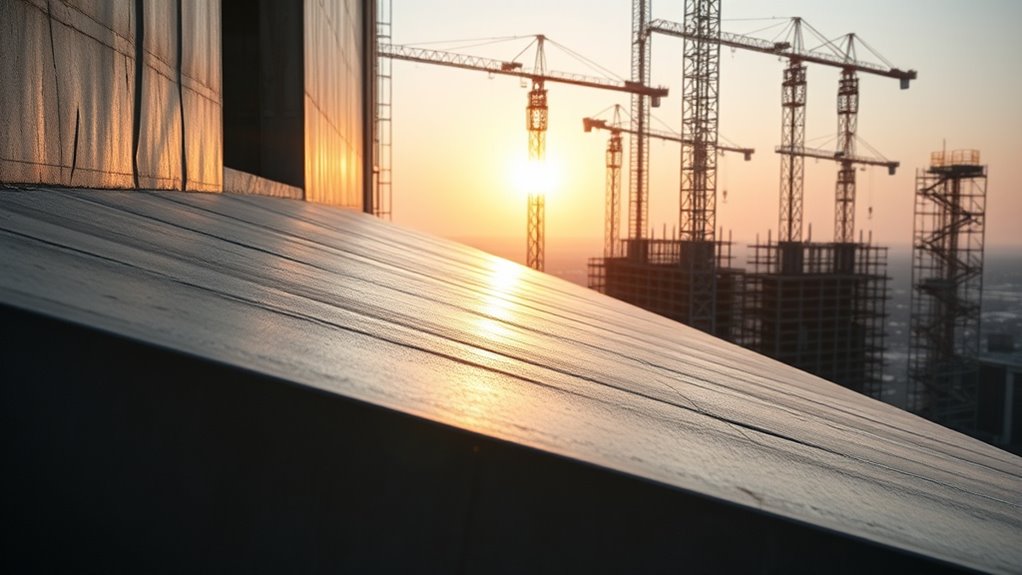
While carbon-negative cement offers promising environmental benefits, its performance and durability in construction applications are critical factors for widespread adoption. You need to ascertain that this innovative material can withstand environmental stresses over time, maintaining structural integrity. Its material durability directly influences long-term safety and reliability, while a low carbon footprint is essential for sustainable construction. Additionally, understanding the material’s resistance to chemical degradation is vital to ensure it remains effective in various environmental conditions over decades. Research indicates that incorporating sustainable materials can enhance overall durability and resistance to environmental factors, making it more suitable for long-term use. Moreover, advanced testing methods are crucial to accurately assess the long-term performance of this eco-friendly cement under real-world conditions.
Cost and Economic Viability for Builders
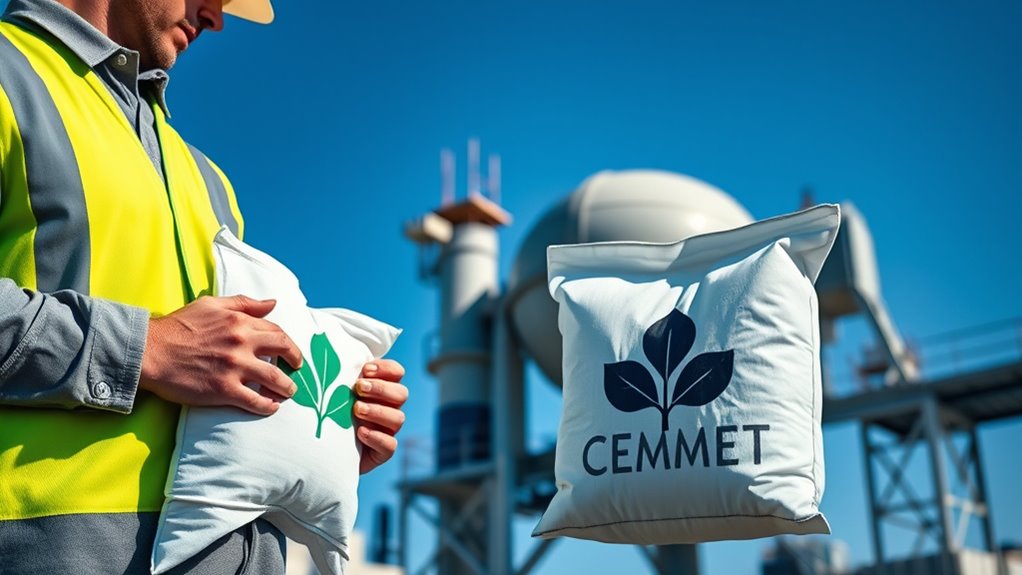
Evaluating the cost and economic viability of carbon-negative cement is essential for its adoption in construction projects. A thorough cost analysis helps you understand the initial expenses, including material production and transportation, compared to traditional cement. While the upfront costs may be higher, consider long-term savings from potential energy efficiencies and carbon credits. As market adoption increases, economies of scale could reduce prices, making this sustainable option more competitive. Your decision to use carbon-negative cement hinges on balancing these costs against environmental benefits and regulatory incentives. Although it might currently be priced above conventional options, growing demand and improved production methods could enhance its economic viability. Ultimately, understanding these financial factors is key to integrating this innovative material into your projects.
Industry Reactions and Adoption Challenges
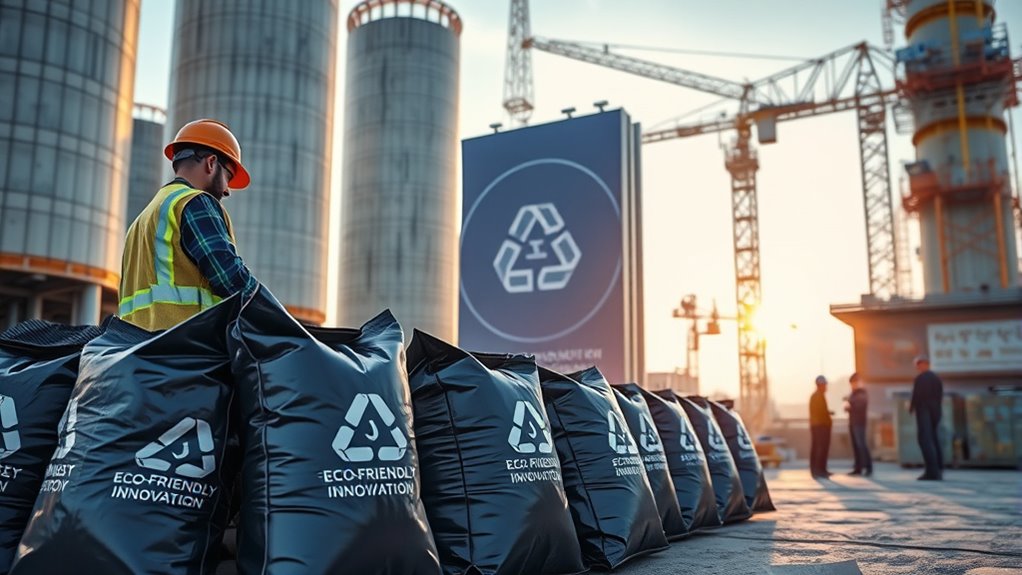
The industry’s response to carbon-negative cement has been mixed, with many stakeholders showing cautious optimism while others express skepticism about its readiness for widespread adoption. Market acceptance remains uncertain, as builders and developers weigh the environmental benefits against costs and reliability. Regulatory hurdles also pose significant challenges, with unclear guidelines and slow approval processes delaying adoption. You might encounter resistance from traditional cement producers worried about losing market share. Some companies are hesitant due to limited long-term data on performance and durability. To succeed, proponents need to address these concerns head-on.
- Overcoming regulatory barriers to approval
- Demonstrating consistent performance and durability
- Gaining trust from industry leaders
- Navigating resistance from established players
Potential for Transforming Global Infrastructure
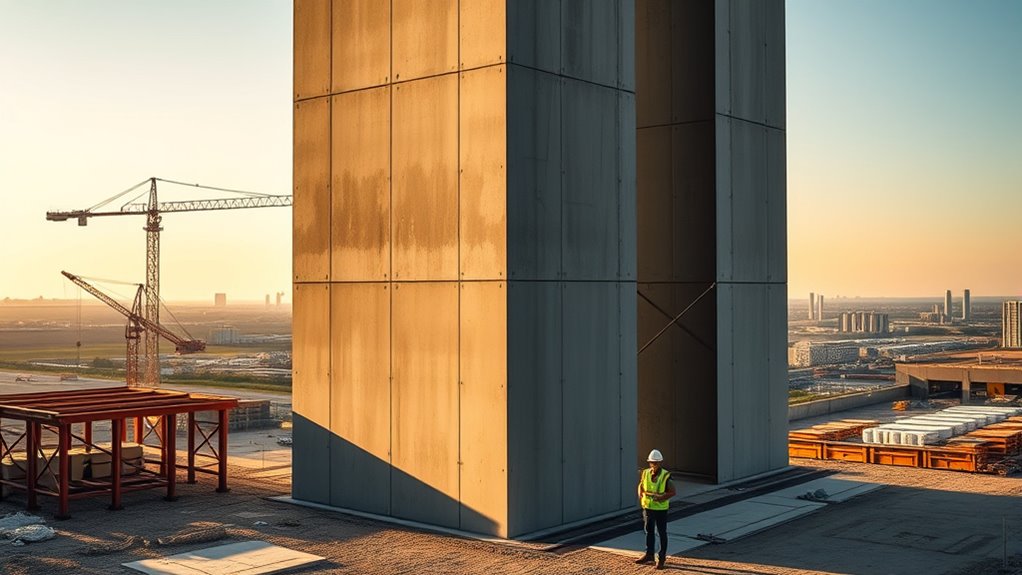
You can considerably cut construction emissions by adopting carbon-negative cement, making infrastructure projects greener. This shift also boosts long-term sustainability, reducing environmental impact across global networks. Embracing these innovations has the potential to reshape how we build and maintain infrastructure worldwide.
Reducing Construction Emissions
Reducing construction emissions presents a substantial opportunity to transform global infrastructure toward sustainability. By adopting innovative practices, you can minimize carbon footprints and promote climate resilience. Using materials that enable carbon sequestration helps lock away CO₂ during construction, turning buildings into carbon sinks. Embracing renewable energy sources for manufacturing and construction processes further cuts emissions and reduces reliance on fossil fuels. Strategies like optimizing design for efficiency, utilizing low-carbon materials, and implementing green building standards can considerably lower overall emissions. Additionally, integrating carbon-negative cement into projects not only reduces emissions but actively contributes to carbon removal. These approaches empower you to lead the charge toward a cleaner, greener infrastructure future.
- Incorporate carbon sequestration techniques in construction
- Shift to renewable energy sources
- Use low-carbon, sustainable materials
- Adopt green building standards
Enhancing Infrastructure Sustainability
Implementing sustainable practices in infrastructure not only lowers environmental impacts but also opens new opportunities for long-term resilience and efficiency. By integrating material innovation, you can develop construction materials that actively contribute to carbon sequestration, capturing CO2 during or after production. This transforms traditional infrastructure into a tool for climate mitigation rather than just an end-user of resources. Carbon-negative cement exemplifies this shift, reducing emissions while enhancing durability. As you adopt these advanced materials, you boost infrastructure longevity and reduce maintenance costs. This approach creates a more sustainable built environment, capable of adapting to climate challenges. Ultimately, embracing sustainable practices in infrastructure paves the way for a resilient, low-carbon future, leveraging technology to make global development more environmentally responsible.
Future Developments and Next-Generation Materials
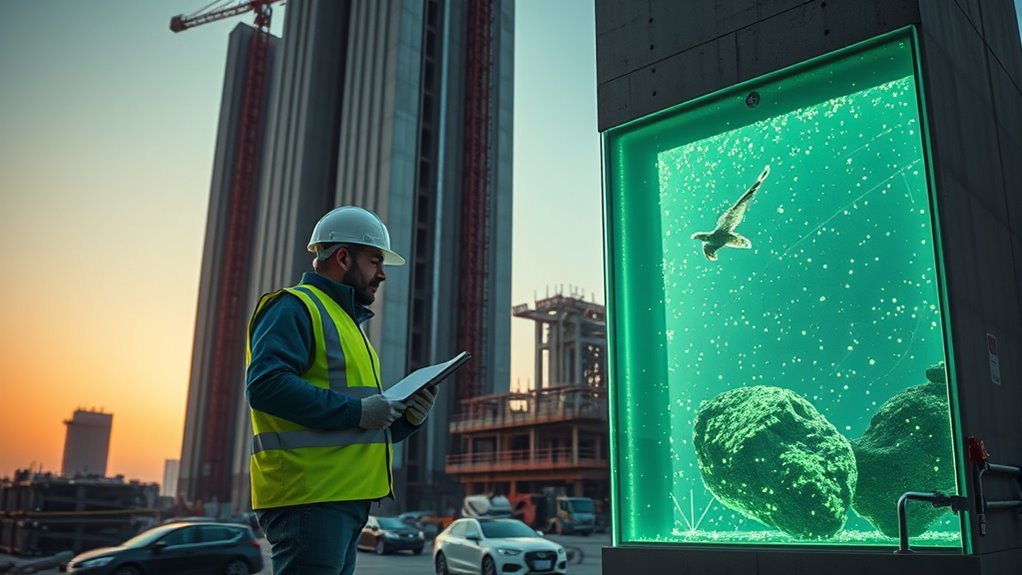
As research into carbon-negative cement advances, scientists are developing next-generation materials that could revolutionize the construction industry. These innovations focus on integrating renewable energy sources during production and enhancing material recycling processes to reduce waste. Future materials may use bio-based components or incorporate industrial byproducts, lowering reliance on traditional raw materials. Advanced composites could offer increased strength and durability while maintaining eco-friendliness. Researchers are also exploring self-healing capabilities and adaptable properties to extend infrastructure lifespan. These developments aim to make construction more sustainable and efficient, addressing climate challenges head-on. By combining renewable energy, innovative recycling techniques, and smarter material design, the next wave of construction materials promises a more resilient, environmentally friendly future.
Steps Toward Widespread Implementation
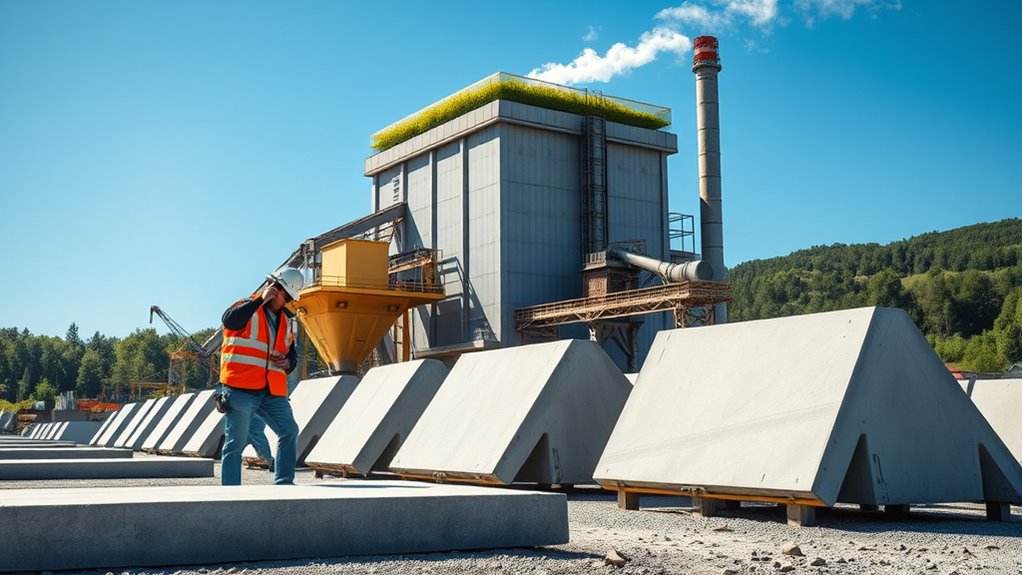
Advancing carbon-negative cement from laboratory research to widespread use requires addressing practical challenges and establishing clear pathways for adoption. Urban planning plays a vital role, as cities need to incorporate this sustainable material into their development projects, updating codes and standards to encourage its use. Streamlining the supply chain is essential, ensuring raw materials are available locally to reduce transportation emissions and costs. Collaboration between manufacturers, regulators, and construction firms can facilitate smoother adoption. Pilot projects and demonstration sites will showcase its benefits, building confidence among stakeholders. Education and incentives can further accelerate acceptance. By focusing on these steps—integrating urban planning strategies and optimizing supply chains—you can help shift this innovative cement from niche application to mainstream construction material.
Frequently Asked Questions
How Long Has This Carbon-Negative Cement Been in Development?
You might wonder how long this carbon-negative cement has been in development. The development timeline spans several years, with research milestones marking key progress points. Researchers focused on innovative materials and sustainable processes, steadily refining the formula. Throughout this journey, they overcame technical challenges, leading to successful testing phases. Overall, the development likely took around 5 to 7 years, showcasing dedication to creating a more eco-friendly construction material.
Are There Any Known Limitations or Disadvantages Compared to Traditional Cement?
Some skepticism surrounds this innovative cement, sparking questions about limitations. You might find that environmental impact benefits are promising, yet cost considerations could pose challenges for widespread adoption. Traditional cement’s familiarity and established supply chains might make it cheaper initially, but the carbon-negative option could face hurdles in scaling up. While it’s eco-friendly, you should weigh these disadvantages against its long-term environmental advantages, understanding that early-stage innovations often face such hurdles.
What Specific Industries Are Expected to Adopt This Cement First?
You’ll likely see the construction materials industry adopt this cement first, especially in green building projects aiming for sustainability. Architects and builders focused on eco-friendly designs will choose it to reduce carbon footprints. The industry’s shift toward greener alternatives makes this cement appealing for large-scale infrastructure and commercial developments seeking sustainable credentials. Its eco-friendly profile aligns perfectly with the increasing demand for environmentally conscious construction materials in modern construction projects.
How Scalable Is the Production Process for Global Demand?
Imagine a vast factory humming with mass production, seamlessly integrating into global supply chains. You see the potential to scale this cement, as advancements in technology and infrastructure support increased output. Its production process can be expanded efficiently, meeting rising demand worldwide. With careful planning, the supply chain adapts smoothly, ensuring this innovative cement becomes accessible everywhere, making a significant environmental impact while fulfilling construction needs across diverse markets.
What Are the Regulatory Hurdles for Widespread Market Acceptance?
You’ll need to navigate policy barriers and safety standards to guarantee widespread market acceptance. Regulations vary by region, and some may not yet recognize or support innovative cement technologies. You should work closely with regulators to meet safety standards and demonstrate the environmental benefits. Addressing these hurdles early helps build trust, accelerates approval processes, and encourages adoption, making your product more attractive to builders and policymakers alike.
Conclusion
You can be part of the powerful shift toward a sustainable future by embracing pioneering, planet-positive cement. With its carbon-cutting creativity and concrete climate benefits, this groundbreaking innovation promises progress and progressiveness. By backing bold, biodegradable building blocks, you help harness hope, heal habitats, and herald a healthier horizon. Together, through transformative technology and tireless teamwork, you can turn today’s trends into tomorrow’s triumphs, transforming terrains and tackling climate challenges with tangible, trailblazing tools.
